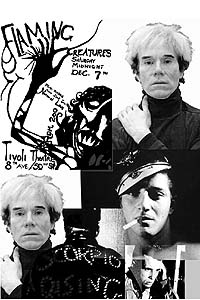Scholars to examine queer aesthetic in films
By Jennifer CarnigNews Office
Long before Brokeback Mountain hit the big screen, films such as Kenneth Anger’s Scorpio Rising, Jack Smith’s Flaming Creatures and Andy Warhol’s Chelsea Girls brought queer imagery to the 1960s art house circuit. Now a new film series will bring these and other films from the genre to campus each Friday through Feb. 10.
Though these films are widely regarded as some of the most important and influential films of postwar underground cinema, only recently have cinema scholars begun to take seriously the fact that Anger, Smith and Warhol were filmmakers whose work delivered a “distinctly queer aesthetic,” said Ron Gregg, Lecturer and Director of Programming for Cinema & Media Studies.
In an attempt to explore the idea of a queer aesthetic further, Gregg—along with George Chauncey, Professor in History and the College and Director of the Center for Gender Studies, and Michelle Puetz, a Cinema & Media Studies graduate student and coordinator of the Experimental Film Club—organized a film series that will offer screenings every Friday through Feb. 10. “Beyond Warhol, Smith and Anger: Recovering the Significance of Postwar Queer Underground Cinema, 1950-1968” will include two dozen films created by mostly New York-based filmmakers, performers, writers and artists.
Not all of the filmmakers included in the series were gay, but “their creative energies came out of a highly gay influenced cultural world,” Gregg said. “Almost all of the men were gay, most of the women were heterosexual but resolutely anti-heteronormative, and many worked closely with gay men in this gay-dominated filmmaking milieu,” he explained.
 | |
The result is a library of films that draw on iconography widely used and recognized in the gay world as well as films that explore queer subjectivity. Willard Maas and Ben Moore’s 1956 film Narcissus, for example, depicts a young man creating a queer world for himself in a devastated urban environment. He not only visits a gay bar in a dream sequence, but he picks up a range of articles on the debris-filled streets that are rich with gay meanings. Films such as Narcissus have never been looked at in concert with films from the same time, place and cultural disposition, Gregg said. Viewing and analyzing these films as a group, the series organizers hope, will provide new perspectives on the emergence and meaning of queer aesthetics in the 1950s and 1960s.
“The field has still barely registered that (these filmmakers) were not just brilliant auteurs but were enmeshed in and influenced by a larger circle,” Gregg said. These screenings—and an accompanying symposium set for Friday, April 7 and Saturday, April 8 —will seek to “map the contours of this wider cultural formation, which we call postwar queer underground cinema.”
This cinema largely developed in the 1950s and ’60s in the ferment of New York’s East Village, the scene of complex interactions, collaborations and conflicts between mostly gay or bisexual filmmakers and between white and Puerto Rican bohemian, queer and street cultures.
Organized by the Lesbian and Gay Studies Project in cooperation with the Committee on Cinema & Media Studies, the Film Studies Center and the Experimental Film Club, the series began Friday, Jan. 13, with a screening of Anger’s Scorpio Rising (1963), Smith’s Flaming Creatures (1963) and Warhol’s My Hustler (1965).
It continues at 7 p.m. Friday, Jan. 20, with the theme, “Mythology and Abstraction in Queer Representation.” The films to be screened are: Geography of the Body (Maas, 1943), Puce Moment (Anger, 1949), Eaux d’ Artifice (Anger, 1953), Bagatelle for Willard Maas (Marie Menken, 1961), Arabesque for Kenneth Anger (Menken, 1961), Swain (Gregory Markopoulos, 1950), Mechanics of Love (Maas and Moore, 1955), Narcissus (Maas and Moore, 1956) and Dionysius (Charles Boltenhouse, 1963).
At 7 p.m. Friday, Jan. 27, the topic will be “Women Looking (At) Queer.” The films to be screened are: Face (Takahiko Iiamura, 1968), Christmas on Earth (Barbara Rubin, 1962) and Portrait of Jason (Shirley Clarke, 1967).
The series continues at 7 p.m. Friday, Feb. 3, with the topic “The Gender Question/Questioning Gender.” The films to be screened are: Behind Every Good Man (Nikolai Ursin, 1965), Chumlum (Ron Rice, 1964), Dirt (Piero Heliczer, 1965), Avocada (Bill Vehr, 1966), Private Imaginings and Narrative Facts (Edward Owens) and Tomorrow’s Promise (Owens, 1967).
The series will conclude at 8 p.m. Friday, Feb. 10, with a visit by filmmaker Jose Rodriguez-Soltero. The films to be screened are: Jerovi (Rodriguez-Soltero, 1965), Lupe (Rodriguez-Soltero, 1966) and Lupe (Warhol, 1966).
All of the screenings are free and open to the public and will be held in the Film Studies Center Auditorium, Room 307, Cobb Hall, 5811 S. Ellis Ave. For more information, call (773) 702-8596 or visit http://filmstudiescenter.uchicago.edu.
![[Chronicle]](/images/sidebar_header_oct06.gif)